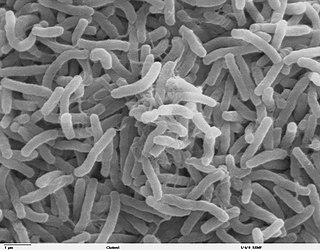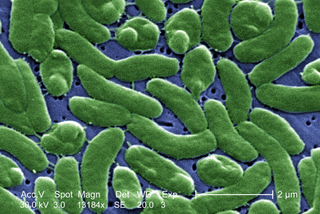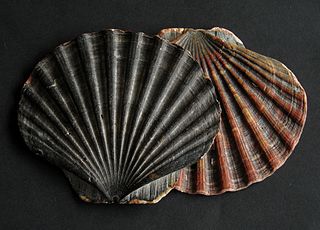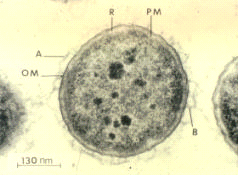
A pilus is a hair-like appendage found on the surface of many bacteria and archaea. The terms pilus and fimbria can be used interchangeably, although some researchers reserve the term pilus for the appendage required for bacterial conjugation. All pili in the latter sense are primarily composed of pilin proteins, which are oligomeric.

Vibrio cholerae is a species of Gram-negative, facultative anaerobe and comma-shaped bacteria. The bacteria naturally live in brackish or saltwater where they attach themselves easily to the chitin-containing shells of crabs, shrimps, and other shellfish. Some strains of V. cholerae are pathogenic to humans and cause a deadly disease cholera, which can be derived from the consumption of undercooked or raw marine life species.

Vibrio is a genus of Gram-negative bacteria, possessing a curved-rod (comma) shape, several species of which can cause foodborne infection, usually associated with eating undercooked seafood. Typically found in salt water, Vibrio species are facultative anaerobes that test positive for oxidase and do not form spores. All members of the genus are motile. They are able to have polar or lateral flagellum with or without sheaths. Vibrio species typically possess two chromosomes, which is unusual for bacteria. Each chromosome has a distinct and independent origin of replication, and are conserved together over time in the genus. Recent phylogenies have been constructed based on a suite of genes.

Vibrio vulnificus is a species of Gram-negative, motile, curved rod-shaped (bacillus), pathogenic bacteria of the genus Vibrio. Present in marine environments such as estuaries, brackish ponds, or coastal areas, V. vulnificus is related to V. cholerae, the causative agent of cholera. At least one strain of V. vulnificus is bioluminescent.

Vibrio parahaemolyticus is a curved, rod-shaped, Gram-negative bacterium found in the sea and in estuaries which, when ingested, causes gastrointestinal illness in humans. V. parahaemolyticus is oxidase positive, facultatively aerobic, and does not form spores. Like other members of the genus Vibrio, this species is motile, with a single, polar flagellum.
Vibrio natriegens is a Gram-negative marine bacterium. It was first isolated from salt marsh mud. It is a salt-loving organism (halophile) requiring about 2% NaCl for growth. It reacts well to the presence of sodium ions which appear to stimulate growth in Vibrio species, to stabilise the cell membrane, and to affect sodium-dependent transport and mobility. Under optimum conditions, and all nutrients provided, the doubling time of V. natriegens can be less than 10 minutes. In the laboratory, the growth medium can be easily changed, thus affecting the growth rate of a culture. V. natriegens is commonly found in estuarine mud. S.I. Paul et al. (2021) isolated and identified many strains of Vibrio natriegens from marine sponges of the Saint Martin's Island Area of the Bay of Bengal, Bangladesh.
Vibrio alginolyticus is a Gram-negative marine bacterium. It is medically important since it causes otitis and wound infection. It is also present in the bodies of animals such as pufferfish, where it is responsible for the production of the potent neurotoxin, tetrodotoxin.
Lysinibacillus sphaericus is a Gram-positive, mesophilic, rod-shaped bacterium commonly found on soil. It can form resistant endospores that are tolerant to high temperatures, chemicals and ultraviolet light and can remain viable for long periods of time. It is of particular interest to the World Health Organization due to the larvicide effect of some strains against two mosquito genera, more effective than Bacillus thuringiensis, frequently used as a biological pest control. L. sphaericus cells in a vegetative state are also effective against Aedes aegypti larvae, an important vector of yellow fever and dengue viruses.

Pecten maximus, common names the great scallop, king scallop, St James shell or escallop, is a northeast Atlantic species of scallop, an edible saltwater clam, a marine bivalve mollusc in the family Pectinidae. This is the type species of the genus. This species may be conspecific with Pecten jacobaeus, the pilgrim's scallop, which has a much more restricted distribution.

Aeromonas salmonicida is a pathogenic bacterium that severely impacts salmonid populations and other species. It was first discovered in a Bavarian brown trout hatchery by Emmerich and Weibel in 1894. Aeromonas salmonicida's ability to infect a variety of hosts, multiply, and adapt, make it a prime virulent bacterium. A. salmonicida is an etiological agent for furunculosis, a disease that causes sepsis, haemorrhages, muscle lesions, inflammation of the lower intestine, spleen enlargement, and death in freshwater fish populations. It is found worldwide with the exception of South America. The major route of contamination is poor water quality; however, it can also be associated stress factors such as overcrowding, high temperatures, and trauma. Spawning and smolting fish are prime victims of furunculosis due to their immunocompromised state of being.
Vibrio campbellii is a Gram-negative, curved rod-shaped, marine bacterium closely related to its sister species, Vibrio harveyi. It is an emerging pathogen in aquatic organisms.
Vibrio furnissii is a Gram-negative, rod-shaped bacterium. Its type strain is ATCC 35016. V. furnissii is aerogenic (gas-producing), and uses L-rhamnose, L-arginine, L-arabinose, maltose, and D-mannitol, but not L-lysine, L-ornithine, or lactose. It has been isolated from patients with gastroenteritis, bacteremia, skin lesions, and sepsis.
Vibrio coralliilyticus is a Gram-negative, rod-shaped bacterium. It has a polar flagellum that is used for motility and has been shown to be critical for its virulence to corals. It is a versatile pathogen, impacting several marine invertebrates including Pocillopora damicornis corals, both the Pacific and Eastern Oyster’s larvae and some vertebrates such as the rainbow trout. It is a bacterium of considerable interest given its direct contribution to temperature dependent coral bleaching as well as its impacts on aquaculture where it can contribute to significant mortalities in larval oyster hatcheries. There are several known virulent strains, which appear on both the Pacific and Atlantic Coasts of the United States. After its initial discovery some strains were incorrectly classified as Vibrio tubiashii including the RE22 and RE98 strains but were later reclassified as Vibrio coralliilyticus.
Vibrio tapetis is a Gram-negative, rod-shaped bacterium, the causative agent of the brown ring disease that affects cultured clams. B1090 is the type strain.
Streptomyces turgidiscabies is a streptomycete bacterium species, causing scab in potatoes. It has flexuous spore, the latter which are cylindrical and smooth. The type strain is SY9113T. It is almost identical to Streptomyces reticuliscabiei, however they are considered distinct species given the diseases they cause are different.
Tenacibaculum is a Gram-negative and motile bacterial genus from the family of Flavobacteriaceae.
Vibrio tubiashii is a Gram-negative, rod-shaped (0.5 um-1.5 um) marine bacterium that uses a single polar flagellum for motility. It has been implicated in several diseases of marine organisms.
Vibrio lentus is a species of Gram-negative bacteria found in marine environments. It was first isolated from Mediterranean oysters. It is pathogenic to octopuses and has been found to cause skin lesions, exposure of muscle, and sometimes death.
Neptuniibacter marinus is a Gram-negative, aerobic and motile bacterium from the genus of Neptuniibacter which has been isolated from the scallop Pecten maximus.
Neptuniibacter pectenicola is a Gram-negative, aerobic and motile bacterium from the genus of Neptuniibacter which has been isolated from the scallop Pecten maximus.






